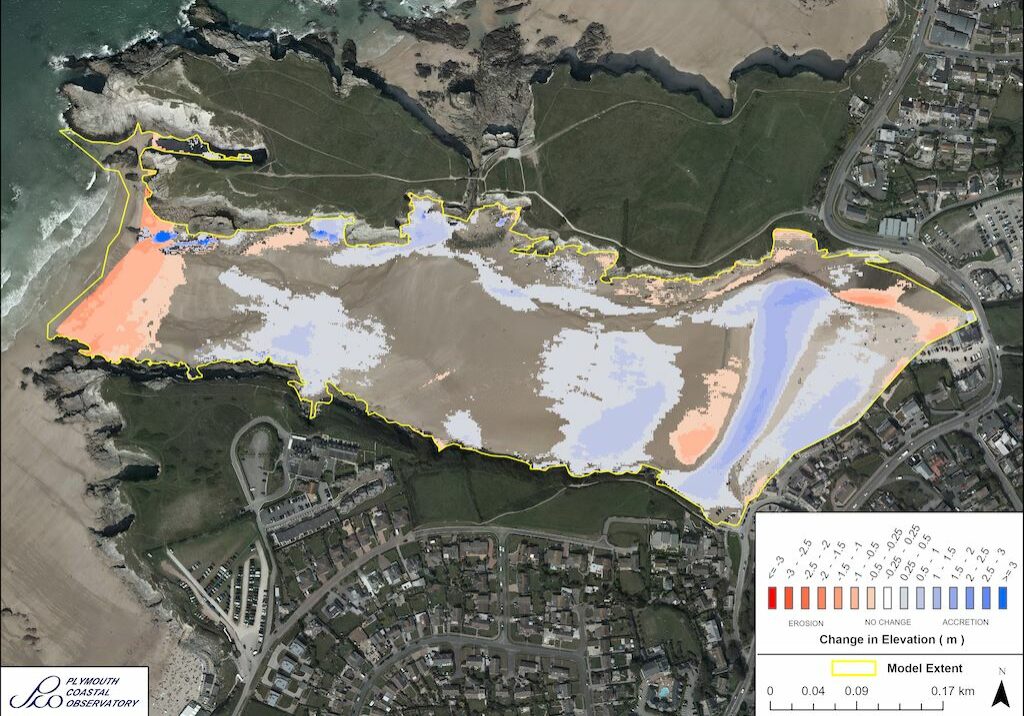
Porth, or St Columb Porth (Cornish: ‘Porth’, meaning ‘cove of St Columb’), is a west facing deeply incised bay to the north of Newquay and at the edge of Newquay Bay. Porth is located at the mouth of Porth Stream, which flows along the northern flank of the beach. Porth Stream is fed by the St Mawgan Stream and a number of other smaller streams, which when combined create quite an extensive catchment.
Porth is a long narrow beach, fringed by low and steep cliffs. The southern cliff of Winecove Point, now defines the northern extent of Newquay, whilst the northern cliffs of Trevelgue Head remain undeveloped, but provide evidence of the importance of the site, with the remains of an Iron Age Castle and Bronze Age barrows (tumuli).
The sediment on Porth consists of fine golden sand, the shape of the bay means that large areas of sand on the uppershore are permanently exposed, and as such, prone to blow inland.
The southern side of the uppershore of the beach is fringed by property, many of which have integrated seawalls in their construction, creating a boundary between the natural and built environment that prevents the beach from rolling back into the valley it formally would have extended into.


Coastal Change
The coastline of Cornwall is an ever-changing environment. It is energetic, dynamic, never still and changes with each wave and each tidal cycle. Some of the changes we see are gradual and barely noticeable, whilst others, such as rockfalls, happen suddenly and often shockingly.
From one visit to the next it can sometimes be difficult to see how a beach and dune system has changed, but information has been collected, and is being collected through the Making Space for Sand project, to help us better understand how the coastline is changing. The purpose of this section of the website is to understand each location has changed over time, how it could change in the future and understand the policies that influence how we can respond to these changes.
Shoreline Management Plans (SMP)
The Shoreline Management Plan (SMP) is a strategic planning and management assessment tool that helps identify and measure the risk associated coastal erosion and coastal flooding. The document makes a number of policy recommendations over short, medium and long term timeframes setting out a strategic approach to managing the built, natural and historic environments associated with the coastline. Within SMP there are four policy approaches which have been assigned to stretches of coastlines. The four policies are: No Active Intervention (NAI), Hold the Line (HTL), Managed realignment (MR), and Advance the line (ATL).
Porth sits within Policy Development Zone 12 (PDZ12), in Management Area 32 (MA32), within Policy Units (PU) 32.1 and 32.7. The policy recommendations for these policy units are detailed in the table below and the SMP can be accessed through the Cornwall Council website.
Use your touchscreen
to scroll the below table
| Policy Unit | SMP2 Policy Plan | ||||
| 2025 | 2055 | 2105 | Comment | ||
| 32.1 | Undefended cliffs
Main Policy Sub Policy
|
NAI DnD |
NAI DnD |
NAI DnD |
Will meet high level objectives and satisfy AONB and heritage coast criteria. Allow natural coastal evolution to occur to support conservation of designated features. No cliff top assets are deemed to be at risk as a result of this policy. |
| 32.7 | Porth
Main Policy Sub Policy |
HTL RnR
|
MR P |
NAI LAO |
Holding defensive line will protect cliff top properties and route of Watergate to Newquay Rd during epoch 1 but pressure on this frontage means a MR approach is preferred during epoch 2 and resilience and adaptation of the road to flooding along lower section at rear of beach should be considered. Roll back of development out of the risk zone should also be undertaken during this epoch. This allows the community time to adapt and become more resilient while also dealing with the imposing issue of coastal squeeze in the area.
|
| Key Mail Policy: HTL - Hold the Line, A - Advance the Line, NAI – No Active Intervention, MR – Managed Realignment
Sub Policy: DnD – Do not Defend, RnR – Repair not Replace, P – Placeholder, LAO – Local Activity Only |
|||||


National Coastal Erosion Risk Mapping (NCERM)
National Coastal Erosion Risk Mapping (NCERM) provides a baseline of coastal erosion, for the coastline of England, over short, medium and long-term timeframes. The data is based on the natural and defence characteristics of the coastline and provides rates of erosion at differing levels of confidence to help better plan for worse case scenarios. The data provided is for guidance and does not estimate the absolute location of the future coastline.
The basic NCERM lines show erosion estimates for the Short Term (ST-20 years), Medium Term (MT-50 years) and Long Term (LT- 100 years). The data is further categorised by probability: 05 is 5% probability (a 1 in 20 chance of being exceeded) Red Shading, 50 is 50% probability of being exceeded (a 1 in 2 chance of being either exceeded or not exceeded) Orange Shading and 95 is 95% probability (a 19 in 20 chance of being exceeded) Yellow Shading. Click the link below to access the Cornwall Council NCERM Mapping site read the about section then click on layers.
Historical Images of Porth
Historical photographs provide a powerful insight into how the Cornish coastline has changed within the past Century. The Making Space for Sand project are working in collaboration with the Francis Frith collection and have been given permission to share historical images on a number of beaches considered within the project.
In looking back, we can better understand how the coastline has changed, helping us understand not only how the coastal fringe has developed but also the potential future changes that we my observe. When this is considered alongside forecasts of coastal erosion and sea level rise it will help enable us to better adapt to our changing coastline.
Porth beach and car park in 1937 (Image courtesy of the Francis Frith collection) and in 2024.
Porth beach and car park in1955 (Image courtesy of the Francis Frith collection) and in 2024

Modelling Coastal Change

Using data that has already been collected, combined with data collected through the Making Space for Sand project, a series of models will be carried out at each location. This will help us better understand how each location may respond to sea level rise and gain a deeper understanding of how coastal sediments move and behave.
The complexity of the modelling, and the data collection that helps inform it, means that modelling outputs will not be the same on all sites. Some locations will be more thoroughly investigated to understand more complex issues and provide data that can be more widely applied to other sites with similar characteristics.
As the project develops this section of the website will expand, sharing new reports and coastal change projections when they are produced.
LiDAR surveys, which are explained on the Data Modelling page, have been carried out by the South West Coastal Monitoring program at this location. The image shared here visualises where sand has eroded (areas shaded in red) and where it has built up (areas shaded in blue), between the LiDAR surveys carried out in 2003 and 2020. The darker the shade of red or blue the greater the amount of sand erosion or accumulation has been observed. The image helps visualise that beaches are areas that change shape over time and will continue to do so as sea levels rise.


Designations
The coastline represents an important transition between the marine environment and the terrestrial environment. This transition creates a range of special habitats and exposes a range of interesting features, which that can result in these spaces being highly designated and protected. There are a range of designations that recognise a variety of different features. At this location these designations are explored below.
Marine Conservation Zone (MCZ)
A Marine Conservation Zone (MCZ) is a type of marine protected area, designated in English, Welsh and Northern Ireland territorial offshore waters, to protect a range of nationally important, rare or threatened marine habitats or species by halting or reversing damage and degradation caused by human activities.
Image of an assortment of seaweeds (Courtesy of Susan Scott)
The Newquay and Gannel MCZ
The Newquay and the Gannel MCZ covers an area of 900 hectares, extending along the mean high water mark from Kelsey Head to Trevelgue Head. The MCZ protects a high variety of habitats and species. The habitats protected include exposed sandy beaches and rocky shores, where anemones, sponges and sea squirts can be found alongside important species such as the rare giant goby.
Image on an edible crab (Courtesy of Tony Sutton)
Sign up to Making Space for Sand
If you would like to get involved in helping to make dunes more resilient and biodiverse, want to help develop coastal adaptation and emergency plans or just want to know more about what the project is learning about coastal change, please click here:






